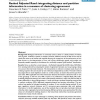212 search results - page 34 / 43 » Comparison of Centralities for Biological Networks |
79
Voted
BMCBI
2007
14 years 11 months ago
2007
Background: Biological information is commonly used to cluster or classify entities of interest such as genes, conditions, species or samples. However, different sources of data c...
93
Voted
BMCBI
2006
14 years 11 months ago
2006
Background: Understanding gene regulatory networks has become one of the central research problems in bioinformatics. More than thirty algorithms have been proposed to identify DN...
BMCBI
2007
14 years 10 months ago
2007
Background: The central role of transcription factors (TFs) in higher eukaryotes has led to much interest in deciphering transcriptional regulatory interactions. Even in the best ...
NN
1998
Springer
14 years 10 months ago
1998
Springer
The selection and control of action is a critical problem for both biological and machine animated systems that must operate in complex real world situations. Visually guided eye ...
106
click to vote
COMCOM
2008
14 years 11 months ago
2008
We present the definition and performance evaluation of a protocol for building and maintaining a connected backbone among the nodes of a wireless sensor networks (WSN). Building ...

